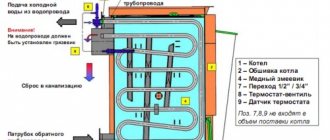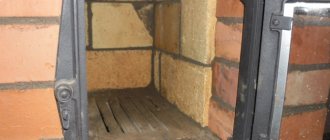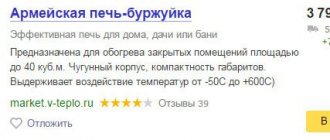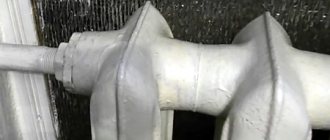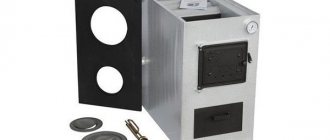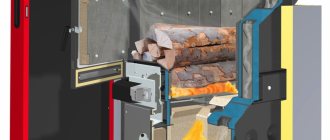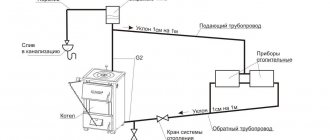How does a coal boiler work?
The long-burning coal boiler has a well-designed structure. They contain a firebox where coal fuel is placed, a water tank, connecting pipes, sensors that transmit the operating parameters of the unit in the form of power and heating temperature.
Long-term coal combustion boilers have a more complex design. Their heat exchanger is not located above the combustion chamber, as in the classic version, but behind it or all around it.
This changes the combustion procedure - the coal burns at a slower pace, it smolders without flames, from the top ball to the bottom, which greatly reduces its consumption.
To improve oxidation, periodic ingress of air mass is required, so that in these boilers an upper combustion system is formed, where air, due to the supply of pumps, is introduced directly into the coal combustion zone. This combustion method reduces the laying period by 1.5-2 times.
How to heat a boiler from theory to practice
Getting the optimal result when burning coal depends on how correctly the technology of all stages of the combustion process is carried out, from loading firewood to replenishing the main fuel in the firebox. Success largely depends on how to light the boiler. The fact is that coal, anthracite or coke, enter the combustion process when the temperature in the combustion center reaches 400-600 degrees. It is simply impossible to achieve this with paper, and solid fuel itself will not be ignited by the fire of a match or a sheet of paper.
Advantages of coal boilers
- Long service time. These devices last 2 years, but in practice, solid fuel boilers operate longer than this.
- Saving money. Long-burning coal boilers consume 2 times less energy compared to gas furnaces and 3 times less than electric convectors.
- Optimal cost. Boilers of this type can be purchased at an affordable price, and in the future you can reduce the cost of paying for the coolant.
Where to buy a coal boiler for heating a private house
- Comfort-Eco, Dmitrovskoe shosse, 100, building 2, tel. +7 (495) 921–37–61.
- My Boiler, Volokolamskoe highway, 116 building 2, tel. +7 (495) 221–56–79.
- TechnoDom, Stachek Ave. 57, Komsomolskaya Square, tel. +7 (812) 671–00–88.
- Kit-Teplo, st. Litovskaya 8, +7 (812) 295–00–05, +7 (812) 248–18–88.
To summarize, it is worth saying that coal boilers are the “golden mean” between ease of use and fuel costs, so if the house is not connected to the gas main, then its installation is completely justified. Even better is the automatic version: it will help you survive even the harsh winter in comfort.
InstructionsLong burning boilersPyrolysis boiler unitsSolid fuel boilersCoal boilers
Boiler with automatic feed
An automatic coal boiler is practical to use; the duration of the process is set on it, for a single placement of fuel, from 3 to 30 days, based on the fuel being loaded, the power and capacity of the container.
- These boilers operate on spilling fuel types: fine coal, pellets, wood chips and other elements.
- Please note that different fuels require different burner structures and fuel delivery mechanisms.
- For example, for pellets the burner corresponding to the name is very suitable, and for coal the best option would be a retort burner with special properties.
- When choosing a given boiler, it is important to determine what fuel will be used for it.
There are universal boilers specifically designed for pellets and fine coal. These boilers contain a container where the fuel is located and a mechanism for transferring this fuel to the combustion section.
Devices for transferring fuel raw materials are made of a mechanical type, operating with the help of augers, and pneumatic, operating on the basis of a compressor for pumping air.
Boilers with automatic transmission can come complete with built-in grates directly into the furnace for stacking coal with firewood. The combustion mode is controlled automatically.
These boilers are often equipped with many different unique functions: self-cleaning, control via telephone and other capabilities.
How and what kind of coal is best to heat a solid fuel boiler
Several grades of hard and brown coal are usually offered for household consumption; in addition, charcoal is also used. But, before loading the firebox with new fuel, you must carefully read the instructions for using the solid fuel boiler; it contains the brands of fuel recommended by the manufacturer.
For domestic and industrial heating boilers, the documentation indicates the optimal grades of coal for use. The fact is that during the production of boilers, finished products are tested and certified for use with different types of fuel. The heat capacity of coal of one group may be higher than the heat capacity of the brands recommended by the manufacturer, which is why the normal operation of the equipment may be at risk.
One of the conditions for how to properly fire a boiler with coal is the correct choice of fuel; in addition to indicating the type and brand, manufacturers recommend focusing on the amount of harmful impurities, dust, ash content and calorific value. This information is indicated in the fuel passport, but what specific qualities a particular brand has is worth finding out in more detail.
Coal
This type of coal is the most common. In most brands, the calorific value averages about 5500-6000 kcal/kg. This indicator is associated with a high hydrocarbon content; this substance makes up about 75% of the mass. When burned, coal produces from 2 to 5% ash, but it is worth saying that this applies to a high-quality product that has been cleaned from rock. Coal grades are divided by fraction size, weight and calorific value. In addition, there is a gradation based on how quickly the fuel burns. Almost all grades of coal are suitable for firing universal solid fuel boilers of the classic type. But such fuel is not suitable for long-burning devices; it has a rather high temperature index, which has a detrimental effect on the equipment.
Brown coal
This fuel is mainly used in the areas where it is mined. It so happened historically that brown coals were not widely used and are mainly a product of local consumption. The calorific value of brown coal is lower than that of hard coal, it is approximately 3000-3200 kcal/kg, this figure is almost 2 times lower than that of the lowest grade of hard coal. A special feature of this product is that after combustion it leaves more ash. In domestic heating installations, brown coal is used, and briquettes made from it with a mass fraction of humidity of about 50%.
Anthracite
When choosing a fuel with the highest calorific value, you should focus on anthracite, one of the best types of coal for combustion in a boiler. The calorific value allows the release of 9000 kcal/kg during combustion, which is one of the highest values. However, after combustion, anthracite forms a large amount of ash, up to 7%, and up to 5-7% of coal that is not burned.
Lignite
This type of coal raw material is intended for consumption in industrial installations. Many manufacturers do not recommend using it in everyday life due to its specific structure and large amount of ash residue.
Coal processing products
Conventionally, these types of products are difficult to attribute to any type of solid fuel made from natural hydrocarbons, but it is also quite difficult to ignore them. This type of product includes coal processing products - coal briquettes and coke.
The first is a briquetted type of fuel obtained by pressing waste from coal recovery at processing plants. Simply put, this is a pressed fine fraction of graded coal that remains after sifting the main mass. Such fuel is mainly used in industrial enterprises, since during combustion it releases a large amount of sulfur, and the ash content in the residue often exceeds 10% of the initial mass.
Coal dust in its pure form is practically not used in individual heating systems, since the technology of burning dust in solid fuel household boilers is not provided. In industrial production, in the energy sector with thermal generation and even in metallurgy, the use of dust is justified; it, in the form of a water-dust mixture, competitively replaces expensive natural gas, but in small boilers designed for 7-15 kW of power, this method is too expensive.
Coking coal, which is the main fuel for blast furnace production of pig iron, can be successfully used at home. However, you need to remember that the energy value ranges from 5.6 to 7.0 thousand kcal/kg. The average ash content is about 8%, volatile substances from 3.2 to 4.2%, sulfur in coke is 1-2%. Pure carbon makes up at least 87% of the substance.
Gas coal
This type of coal is often called flammable coal in everyday life. Saturated with light flammable gases, coal of this group has a small fraction, only 3, maximum 4 cm in diameter. This product is excellent for kindling, because it quickly begins to maintain combustion and also quickly raises the combustion temperature to 400-600 degrees, which is quite enough to ignite the bulk of the main fuel coals. But it’s unlikely to be used for a full-fledged combustion chamber; its calorific value is low, and the combustion time is 4-5 times higher than that of anthracite or coke.
Charcoal
Until the recent past, charcoal was one of the most common coal products. Today this coal has given way to hard coal, but it still remains in demand in private households. When burned, it produces from 7000 to 8000 kcal/kg, which is a good indicator compared to ordinary firewood. After combustion of 84% carbon, 2 to 2.8% ash is formed. It is especially good to use charcoal in solid fuel pyrolysis boilers and long-burning boilers.
Where are coal boilers installed?
Solid fuel coal boilers are installed in residential and commercial buildings - mansions, dachas, various offices located in areas where it is not possible to connect to the gas system.
An excellent option is to use a coal boiler to create heat in a mansion of 100–150 m2.
- Of course, when compared with gas, it burns without a residue, and after the combustion of coal, a lot of ash remains, which means that it has lower combustion efficiency and some of the funds paid for fuel will simply go to waste;
- The owners also use firewood. They are cheaper, but not very convenient to use. You will need to make them yourself to the required size, or spend money on sawing and chopping them, and you will also have to throw them in at intervals of 3-4 hours, while raw coal burns out in 6-10 hours.
Prices: summary table
Price rating of popular models of coal-fired boilers:
| Coal boiler model | Cost, rub. |
| ZOTA "Master" 20 | 34 000 |
| Protherm “Beaver” 20 DLO | 79 000 |
| Bosch "Solid" 2000 B SFU 12 | 80 000 |
| Stropuva S15U | 81 500–99 778 |
| Buderus "Logano" S181-15 E | 252 000–258 840 |
| LIEPSNELE L20U | 110 000 |
| Galmet "CARBO" 21 | 113 890–116 759 |
| ZOTA "Carbon" 20 | 47 900–53 290 |
| Teplodar "Kupper" OVK 10 | 23 050–25 680 |
| Thermocraft "Uragan" Prof 22 | 28 640–34 641 |
Poll: For what reason did you prefer a coal boiler?
- Inability to connect to the gas mains
- Low cost of raw materials (coal)
- Region with developed coal mining
- Longer burning of fuel
- Another reason
- I have not yet decided on the type of boiler to choose
ResultsPoll Options are limited because JavaScript is disabled in your browser.
Ash pan of a pyrolysis boiler fired with coal. To save raw materials, sift the contents of the ash pit through a sieve; the unburnt coal fractions remaining in the sieve can be sent for re-firing!
Classic boilers are not demanding on fuel: they are heated with almost any solid fuel, even household waste, but high performance can only be achieved by using coal with a moisture content of up to 30% and an ash content of up to 25%. Otherwise, the efficiency will be much lower than that declared by the manufacturer.
But the design of pyrolysis boilers and long-term combustion was initially developed to a certain standard, therefore their requirements for fuel quality are higher: coal must not only be low-moisture - up to 20% and low-ash - up to 15%, but also have a fixed size - from 5 to 25 mm.
Operating principle of a coal boiler
With the help of the chimney draft, air enters the stove, which supports the necessary combustion of coal and heated gases appear. They heat the walls inside, convert the heat into heated steam or impart it to the water passing through the heat exchanger device.
The heated water is supplied to the heating pipes of the entire building, and then, after completing the entire cycle, it enters the boiler again. The released thermal gases go into the chimney, where, with the help of their energy, the temperature necessary for good draft is formed.
Pyrolysis boiler
The main difference between pyrolysis units is that they have two connected stoves: in the first, coal burns and heated gases are generated, and in the second, these gases are completely burned, before leaving the device they cool and have almost no smoke.
Thus, the unburnt portions of the exhaust gases are oxidized and produce additional energy used to heat the thermal fluid. This increases the efficiency of the boiler and ensures that the fuel burns out most efficiently, which extends the burnout time of one stack of raw materials to 24-30 hours, and if there is a bunker, then up to 4-7 days.
Guidelines for selection
You can make the right choice using the project, which should include all the design characteristics, methods of connecting communications and other parameters. You can find the necessary information in the instructions for using the device.
Determining main criteria:
- Type of housing material. The material used to produce the housing affects the repairability. Steel is resistant to changes in temperature and pressure, but is susceptible to rust and burnout.
- Cast iron is a long-lasting material on which high furnace power can be used, but it does not tolerate shocks and sudden temperature changes. If there is a small hole, the steel body can be welded, but when a crack appears in the cast iron, the entire assembly will need to be replaced.
- Manufacturers often make steel-clad boilers with a cast-iron stove.
- Single-circuit or double-circuit. With a single circuit, designed only for heating rooms, it is connected to a number of radiators and heats water exclusively for them. Consisting of two circuits, it is used both for heating rooms in the house and for heating water for residential needs and is supplied to heated floors.
- Minimum required power and heated area. The power calculation is used in the proportion of 100 W of heat for the entire m2 of room area.
Efficiency - due to it, you can see the ratio of the volume of fuel raw materials to the mass of output heat produced by the device. For a coal boiler, this figure ranges from 65-92%, depending on the structure, type of combustion and level of automation.
What are the prices for coal boilers? The price for coal devices, depending on the manufacturer, varies from 23,000 to 258,000 rubles.

